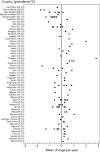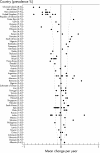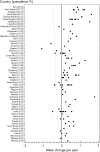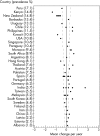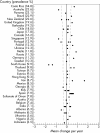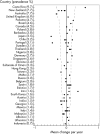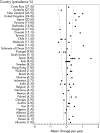Worldwide trends in the prevalence of asthma symptoms: phase III of the International Study of Asthma and Allergies in Childhood (ISAAC)
- PMID: 17504817
- PMCID: PMC2117323
- DOI: 10.1136/thx.2006.070169
Worldwide trends in the prevalence of asthma symptoms: phase III of the International Study of Asthma and Allergies in Childhood (ISAAC)
Abstract
Background: Phase I of the International Study of Asthma and Allergies in Childhood (ISAAC) was designed to allow worldwide comparisons of the prevalence of asthma symptoms. In phase III the phase I survey was repeated in order to assess changes over time.
Methods: The phase I survey was repeated after an interval of 5-10 years in 106 centres in 56 countries in children aged 13-14 years (n = 304,679) and in 66 centres in 37 countries in children aged 6-7 years (n = 193,404).
Results: The mean symptom prevalence of current wheeze in the last 12 months changed slightly from 13.2% to 13.7% in the 13-14 year age group (mean increase of 0.06% per year) and from 11.1% to 11.6% in the 6-7 year age group (mean increase of 0.13% per year). There was also little change in the mean symptom prevalence of severe asthma or the symptom prevalence measured with the asthma video questionnaire. However, the time trends in asthma symptom prevalence showed different regional patterns. In Western Europe, current wheeze decreased by 0.07% per year in children aged 13-14 years but increased by 0.20% per year in children aged 6-7 years. The corresponding findings per year for the other regions in children aged 13-14 years and 6-7 years, respectively, were: Oceania (-0.39% and -0.21%); Latin America (+0.32% and +0.07%); Northern and Eastern Europe (+0.26% and +0.05%); Africa (+0.16% and +0.10%); North America (+0.12% and +0.32%); Eastern Mediterranean (-0.10% and +0.79%); Asia-Pacific (+0.07% and -0.06%); and the Indian subcontinent (+0.02% and +0.06%). There was a particularly marked reduction in current asthma symptom prevalence in English language countries (-0.51% and -0.09%). Similar patterns were observed for symptoms of severe asthma. However, the percentage of children reported to have had asthma at some time in their lives increased by 0.28% per year in the 13-14 year age group and by 0.18% per year in the 6-7 year age group.
Conclusions: These findings indicate that international differences in asthma symptom prevalence have reduced, particularly in the 13-14 year age group, with decreases in prevalence in English speaking countries and Western Europe and increases in prevalence in regions where prevalence was previously low. Although there was little change in the overall prevalence of current wheeze, the percentage of children reported to have had asthma increased significantly, possibly reflecting greater awareness of this condition and/or changes in diagnostic practice. The increases in asthma symptom prevalence in Africa, Latin America and parts of Asia indicate that the global burden of asthma is continuing to rise, but the global prevalence differences are lessening.
Conflict of interest statement
Competing interests: None.
References
-
- Enarson D. Fostering a spirit of critical thinking: the ISAAC story. Int J Tuberc Lung Dis 200591 - PubMed
Publication types
MeSH terms
Grants and funding
LinkOut - more resources
Full Text Sources
Medical

